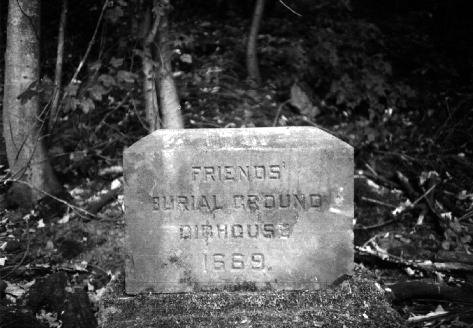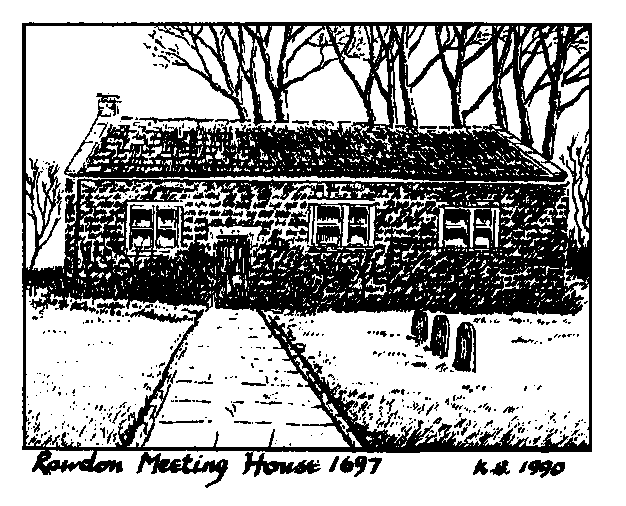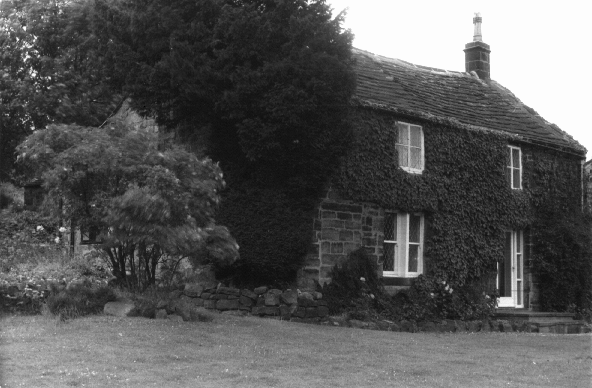 |
This is now part of William Matchell’s Timber Yard and has a commemorative stone to mark the site. Ref.23 |
The Grimshaws of Ivy House. Ref.22
In 1672 Sarah Grimshaw of Ivy House made an application for her home to be used
as a regular Meeting Place. This was after Charles II had issued his Declaration
of Indulgence granting freedom of worship to all non-conformists except Roman
Catholics. Sarah entered her denomination as Independent.
The first Grimshaw at Ivy House was Sarah’s father-in-law, Abraham Grimshaw I
(1603-1670). He was a small farmer and clothier, who was discontented with the
State Church. As early as 1632, two Rawdon dissenters had paid 20 shillings to
purchase a piece of land called Benton Hill with plans for their own place of
worship there.
Before they were able to build a meeting house the Independents met secretly at
Buckstone Common under the huge rock. ( A yearly service is still held there to
commemorate their courage) .
Sarah Grimshaw taught her children not to raise their hats to the gentry, not
out of rudeness but because she did not believe in an attitude of servility to
the ruling classes. For Quakers the annual tithes collected by the local parish
church were a bone of contention. Many refused to pay and were imprisoned. The
Book of Sufferings kept at the Quarterly Meeting at York records that in 1683
Sarah Grimshaw of Rawdon had taken on account of tithes by the servants of
William Breary, priest of Guiseley or his agents - corn valued at £1.5s.
Sarah died in 1695 and was buried on a piece of land at Esholt Springs, Dib
Lane, Guiseley, known as Quaker Wood after it had been released to the
Dissenters as Dibhouse Burial Ground.
 |
This is now part of William Matchell’s Timber Yard and has a commemorative stone to mark the site. Ref.23 |
Her son Josiah had succeeded his father as Master of Ivy House and married Sarah
Ibbitson of Ripon. His eldest sister Marie married James Frankland of Kirby
Moorside. Both these marriage partners were Quakers. How did the young people
meet ?

It can be assumed that Knaresborough Monthly Meeting enabled Quakers from
surrounding villages to meet regularly. Substantial clothiers, like the
Grimshaws, visited the wool fairs at Leeds, Pontefract, Wakefield and Ripon and
their business contacts with other Quakers led in some cases to marriage.
The Quaker Meeting House at Rawdon was built in 1697, standing well back from
the road and with a high wall in front of it. The ground was conveyed to the
Trustees on 15th February 1697. A list of trustees included Josiah
Grimshaw and several other clothiers from Rawdon. Quakers from surrounding
parishes were also allowed to meet there and bury their dead in the graveyard.
The opening of the new Meeting House as a recognised place of worship must have
been a great occasion.
Family Tree
In 1707 Josiah’s younger brother, John moved to Calverley Carr and from him
and Josiah sprang a prolific family, whose descendants are still to be found in
the area today. Abraham, older son of Abraham and Sarah Grimshaw became a wool
stapler and one member of this branch of the family married one of the Hustler
family of Yeadon. John Hustler became the ‘father’ of the Bradford wool
trade.
Jeremiah, Ref.24 the second born, was, through his son Joshua and his wife Jane the
great-great-great grandfather of the Leeds artist John Atkinson Grimshaw.
Jeremiah was one of a deputation which presented a "Humble Address" to
George I from the Yearly Meeting held in London 26th May 1716. A
Letter from Henry Gouldney to Sir John Rodes, 31st May 1716 relates
" … honest Jeramiah Grimshaw was particulery showed to the King,
and gave him a reverend bow, which the king was pleased to returne againe."
Throughout this century the Grimshaws of Ivy House supported Rawdon Meeting.
When sets of trustees were appointed in 1697, 1733 and 1797 included each time
was the master of Ivy House. A pattern of family life there emerges. When a son
succeeds his father as master of Ivy House, the widow or retired couple move
into the cottage. Sons were apprenticed to their fathers as weavers whilst the
women in the family did the spinning. When the cloth was ready it was taken down
to one of the Leeds Cloth Halls to be sold.
In 1733 Abraham III was involved with others, including his cousin John in
drawing up a new lease for the Meeting House. The Meeting House was licensed at
the Quarter Sessions and provided that Friends paid their tithes they were left
alone. It was laid down that Quakers should only marry within the society and
this worked well in the case of the Grimshaws as records of births, marriages
and deaths show.
The trustees indenture of 1765 reveals that Abraham III is the Ivy House
clothier whilst Abraham Junior is the woolcomber.
The Grimshaws also served their local community, caring for the poor and looking
after the highways in Yeadon.
Abraham IV and his wife Eleanor had a family of six boys and two girls.
In 1786, The eldest boy Joseph followed his father as clothier at Ivy House. Two
of his brothers, Abraham and Aaron, also became clothiers and the youngest
Benjamin a grocer, all in Yeadon.
There is evidence that Joseph tried to keep up with the inventions that were
changing wool manufacturing methods. He erected a small, horse powered
scribbling mill in his own yard, but larger textile mills were starting up.
William Thompson built Low Mill down by the river at Calverley in 1796.
In 1797 we read that Joseph Grimshaw and James Thompson have both been appointed
as Trustees of the Meeting House. Joseph Grimshaw is described as a worsted
manufacture and James Thompson as a clothier.
In 1812 three families, descended from Abraham Grimshaw IV, left Rawdon Meeting
after a quarrel there which had made Joseph Grimshaw’s position as first
trustee untenable. The man who took his place was William Thompson of Low Mill.
Moving towards the latter years of the 19th century we find that the
first Rawdon Rate Book dated 1878 states that yet another Abraham Grimshaw was
the occupier of Ivy House and its land which had a rateable value of £34. This
Abraham left Ivy House in 1889 and up to this time his entry in the street
directory of Rawdon was ‘Abraham Grimshaw - cloth buyer and farmer, Ivy House.’
He died in 1902 aged 68 and was buried at Rawdon Baptist Chapel, the last of the
Grimshaws to live at Ivy House. Ref.25
 |
Photograph of Ivy House taken in 1996 by Enid Sheldon with kind permission of the then owners Mr.&Mrs. Lawson. |